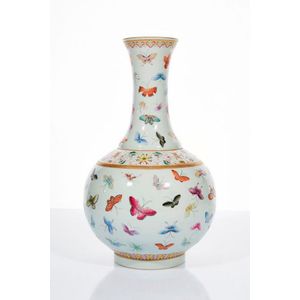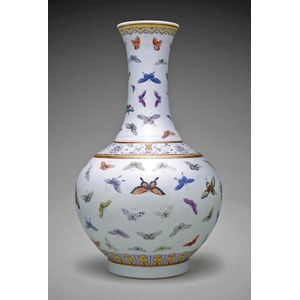Famille-rose Butterfly Vase from Late Qing/Republic Period
You must be a subscriber, and be logged in to view price and dealer details.
Subscribe Now to view actual auction price for this item
When you subscribe, you have the option of setting the currency in which to display prices to $Au, $US, $NZ or Stg.
- Qing Dynasty - The Qing Dynasty was the last imperial dynasty of China, ruling from 1644 to 1912. It was established by the Manchu people, who originated from the northeastern region of China. The Qing Dynasty was preceded by the Ming Dynasty and followed by the Republic of China.
- Republic Period - The Chinese Republic period, also known as the Republic of China period, lasted from 1912 to 1949. It began with the overthrow of the Qing Dynasty in 1911 and the establishment of the Republic of China under Sun Yat-sen. During this period, the country underwent significant political, social, and economic changes, including the adoption of a new constitution, the expansion of civil liberties, and the modernization of the economy. However, the Republic of China period was also marked by political instability, with numerous warlords and factions vying for power and influence, and the country was eventually engulfed in a civil war between the Nationalists and the Communists. The Republic of China period came to an end in 1949, when the Communists emerged victorious and established the People's Republic of China, while the Nationalists retreated to Taiwan where they established a separate government.
This item has been included into following indexes:
- Chinese ceramics, dynasty mark or period
- Chinese ceramics, famille decoration - famille rose, vases 619
- Chinese ceramics, item type - vases, other 2,540
Visually similar items

Chinese famille rose butterfly vase, decorated with a variety of colourful butterflies, with Guangxu six-character iron-red mark to base, height 39 cm, labels: accompanied by receipt from Tong Ji Arcade, in Harbin, China, 4th year of the Japanese Occupatio

Chinese famille rose butterfly vase. Late Qing Dynasty to Republic period, late 19th/20th century, with Guangxu six-character iron-red mark to base. Height 39 cm. Provenance: Purchased from Tong Ji Arcade, in Harbin, China, 4th year of the Japanese Occupat

A 'famille-rose' 'butterfly' vase mark of Guangxu the globular body rising to a trumpet neck, decorated in iron-red and 'famille-rose' enamels with numerous butterflies in flight, divided by a frieze of detached stylised lotus sprays and shou characters ar

A Chinese porcelain bottle shaped vase, Guangxu six character iron red mark to base, decorated with butterflies in overglaze enamels, the shoulder of the vase with a heavy gold rim below a band of flowers, interspersed with the shou character, stylized ruy
